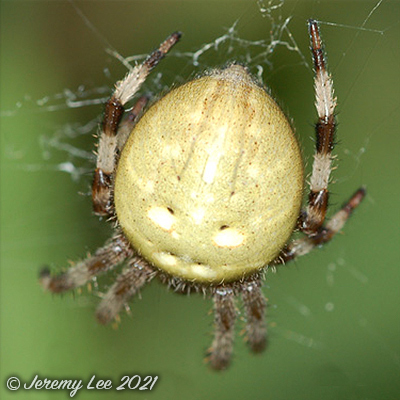
 |
|
Scientific Classifications explained » Amphibians » Ants » Aphids » Bees » Beetles » Birds » Bugs » Butterflies » Caterpillars » Damselflies » Dragonflies » Earwigs » Flies » Frog/Leafhoppers » Fungi » Galls » Grasshoppers » Harvestmen » Hoverflies » Lacewings » Ladybirds » Leaf Mines » Lichens » Mammals » Millipedes » Mosses » Moths » Sawflies » Slugs » Snails » Spiders » Trees & Shrubs » Wasps » Wild Flowers » Woodlice » Postboxes |
UK Nature > Spiders > Araneus quadratus

Scientific Name: Araneus quadratus Common Name: Four Spot Orb Weaver Females of Araneus quadratus, or the Four Spot Orb Weaver, can reach 17 mm in length, especially when gravid, the males approximately half that. They are quite variable in appearance, ranging from pale brown to bright orange or green, but they always have the characteristic four white spots on the abdomen. The legs are sometimes brightly striped. The spider lives in gardens, wooded areas, or wherever there is vegetation to string an orb web across. This species builds its web close to the ground to catch jumping insects such as small grasshoppers. The female builds the more elaborate web, complete with a funnel-shaped retreat off to the side where she goes during inclement weather. The web is smaller and closer to the ground than those of other species of orb-weaver. Adult females can actively change their color. It takes about three days to take on colors that accurately match their resting surface. |
|

https://www.uknature.co.uk is a website dedicated to showing the immense diversity of UK nature and wildlife. Our vast range of habitats, from lowland arable to snow covered mountains, from storm-ravaged coastlines to peaceful inland freshwater lakes and rivers, from dry, sandy heaths to deciduous and coniferous forests, all these habitats contribute to the abundance of UK nature. We have wild birds in huge numbers either residing or visiting our shores (597 recorded species as at July 2013) and we must also not forget the humble back garden with its grass lawns, flower beds filled with nectar rich flowers, shrubs and trees, all designed to attract huge numbers of insects such as bees, moths, butterflies and hoverflies; and finally the small ponds which provide safe havens for frogs, toads, newts and even slow worms and grass snakes. www.uknature.co.uk is the showcase for my personal passion, photographing uknature in all its glory. I sincerely hope you all enjoy the fruits of my labours. This site and all images contained therein is © Jeremy Lee 2004 - 2025. All Rights Reserved. Site design by Jeremy Lee. Site development & IT Support by Stuart Lee. |